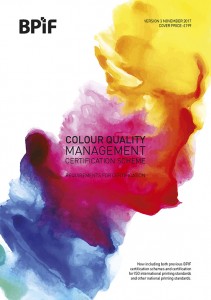Greater interest and some confusion after the BPIF Colour Quality Scheme v3 launch
 Earlier this year, what was formerly called the BPIF ISO 12647 Certification Scheme was relaunched as the BPIF Colour Quality Scheme.
Earlier this year, what was formerly called the BPIF ISO 12647 Certification Scheme was relaunched as the BPIF Colour Quality Scheme.
The revision to the scheme reflects changes in ISO printing standards and aligns its documentation requirements to those of ISO 9001:2015.
This makes the scheme suitable for all ISO and bespoke printing conditions and processes while incorporating the ‘lighter’ documentation need and risk-based approach in ISO 9001.
As a result, many printers, large and small, can see the business advantages and recognise the firm returns on investment, and are showing a greater interest in implementing the scheme.
However, there is still some misunderstanding and confusion; this seems to be caused by the many ‘certifications’ suppliers offer in this area. The main advantages of the BPIF Colour Quality need to be better understood.
- The scheme is completely independent. It is not trying to sell you any hardware, consumables or software. Any advice given by the BPIF in these areas will be based on best practice and suitability for purpose in each case.
- It has been stated that the scheme is heavy on paperwork, placing an unnecessary administrative burden on printers. This is untrue. Incorporating the Colour Quality Scheme within the reduced level of documentation now required by ISO 9001 cuts down the paperwork needed.
- There are two levels of certification: Professional and Elite. Within the Elite level, the areas of certification can include prepress, proofing, platemaking and printing, analogue or digital. In practice, this means that a printer with no need for proofing or prepress can be certified just for printing. In turn, a pre-media and print management company can be certified in just the prepress and proofing areas.
- The scheme’s Elite certification is a product standard. While still having a yearly print test, you can also certify each and every piece of work if you wish. So this is not just a once-a-year snapshot of a printer’s ability to print to the required standard.
- The Professional level is aimed at printers only, and can act as an entry-level certification to the Elite level.
- Finally, the most important fact about the BPIF Colour Quality Scheme: it is third-party audited and certified by independent UKAS (United Kingdom Accreditation Service) accredited certification bodies. This is the form of certification expected by many brands and major clients for standards, such as ISO 9001 and ISO 14001, and product schemes, such as the BPIF Colour Quality Scheme.
Other schemes, at best, offer what is termed second-party certification, with the supplier or consultant implementing the standard or scheme also certifying it – so not the independent certification required in this area by many clients.
Hopefully, this makes clear the options and advantages of the BPIF Colour Quality Scheme over others, and clears the confusion and misconceptions surrounding this area.
Twitter
- Paul Sherfield who runs the consultancy is well known in the printing and pre-media industry as having considerable knowledge on digital workflows, with a special expertise on the business reasoning behind such systems.
He has installed some of the most successful digital pre-press and pre media systems in the UK. For 2 years he worked on a number of medium term projects before starting the consultancy in July 2000. Before this he was a partner in what became one of the leading pre-press/printing companies in London.
He is active in a number of industry groups including the BPIF Technical Standards Committee, ISO TC 130 printing standards committees and is chair of the BPIF steering group for ISO 12647/2 UK certification, He is a regular speaker at seminars and conferences.



